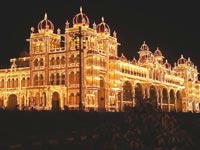Fairytale of 'Chinnada Simhasana'…

Mysore, Sept 21 :
The majestic jewel-studded Chinnada Simhasana, popularly known as the Mysore Golden Throne is the ambassador of world famous Mysore Dasara and tourists both domestic and foreigners, are thronging the Mysore Palace just to have a glimpse of the throne, which will be on display only during days of Navarathri.
The palace guides and hand books are just not enough to explain the fairytale of the ceremonial throne. Top News Network brings you the making and journey of ceremonial 'Chinnada Simhasana'. Originally made of figwood and decorated with ivory plaques, the golden throne consists of the main seat, a staircase and golden umbrella, all of which are attached through an interlocking mechanism and installed as one piece during the Navaratri festivities. A 24-verse Sanskrit "sloka" has been engraved on the rim of the umbrella addressed to Krishnaraja Wadiyar III, making references to his ancestors. Says a legend, this throne belonged to the Pandavas of Mahabharata fame and was in Hastinapura. Kampilaraya brought this throne from Hastinapura to Penugonda, in Andhra Pradesh where it was kept under ground.
Later, Vijayanagar kings used this auspicious throne at Anegondi, for two centuries. During the early part of the 17th century, the Governor of Vijayanagar rules at Srirangapatna obtained and brought it, before gifting it to Raja Wodeyar. In 1610, Raja Wodeyar, ascended this throne with pomp and pageantry and inaugurated the Dasara festivites. Epigraphical evidence shows that this throne was in possession of Chikkadevaraja Wodeyar in 1699. Further historical records show that it was with the royal family till the time of Tipu Sultan.
After the fall of Tipu Sultan, this throne was recovered from a room in the Sultan's Palace in Srirangapatna. It is learnt that this royal seat was quickly renovated and used in the coronation of the child Raja, Krishnaraja Wodeyar III, in 1799. Since then, this ceremonial throne has remained with the Mysore royal family.
In Sanskrit work called "Devatanama Kusukamanjari" composed by King Krishnaraja Wodeyar III, in 1859, there is a detailed description of the Golden Throne. Although it has undergone slight alternations in the 1940s, it has retained the original artistic, decorative features. Reckoned to be a spectacular work of art that adorns the Amba Vilas section of the main palace, the golden throne is kept under strict security in the strong room and is displayed only during the Dasara.



